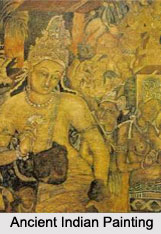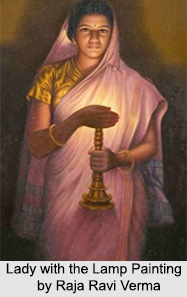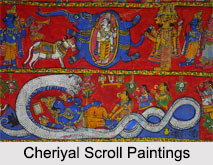 Assamese paintings go far back and can be expanded to the Puranic period. The traditional paintings of Assam provide as a resource of encouragement to thousands of art lovers across the world. Recognized for their supreme excellence and wonderful strokes of mastery, they have become an essential part of the rich Assamese culture.
Assamese paintings go far back and can be expanded to the Puranic period. The traditional paintings of Assam provide as a resource of encouragement to thousands of art lovers across the world. Recognized for their supreme excellence and wonderful strokes of mastery, they have become an essential part of the rich Assamese culture.
There are a number of Assamese scripts, where the folk relationship is established to an elevated level as well. In medieval Assam, different classes of painters developed with moment.
History of Assamese Paintings
Assamese paintings and manuscripts are said to have been derived from the mythical stories and the most famous among them are "Chitra Bhagavata" and "Hastividyaranya" and in the "Gita Govinda". Most of these manuscripts have been collected from diverse parts of the state and published in the form of books, along with the copy in the structure of paintings. The medieval painters used nearby manufactured painting materials such as the colours of hangool and haital.
There are common references in medieval Assamese paintings called pats and to a class of painters called patuas. But patuas are no longer to be found in Assam. In Kamrup, there is an appearance still present, which points to the tradition of painting associated with another community. There was another class of artists called khanikars who were resourceful in doing all kinds of artistic work like make-up and stage-set for theatrical performances. The paintings they do are done to ornament the carved panels, masks, pedestals, book-stands and so on.
Features of Assamese Paintings
The common work consists of a large middle area usually painted red where the subjects are depicted and a thin immediate border in green or blue, a border at the top, forming a series of canopies over the central area. The male and female figures are constantly conventional and excluding in the depiction of Brahma, all figures are depicted in profile. The dealing of landscape is always conventional. Water is painted in a basket outline inside squares and rectangles. Trees are normally painted like sprays. Mountains are depicted as piles of multi-coloured curved bodies. The portrayal of animals and birds are both conventional and naturalistic. The architecture is very easy, consisting of a cross-section view of the Assam type house with roofs and supporting pillars. Another feature of the Assamese school is the depiction of the landscape separately. Such landscape is an unusual trend in other schools. Small paintings of the Assamese school have always remained in parallel format while in other parts of India they changed it to the upright format. Another important feature of the Assamese manuscript is its calligraphic style, which led to the development of four stylistically different types of Assamese scripts - Gargaiyan, Bamunia, Lahkari and Kaitheli. The use of a simple mixture of chalk in the grounding of the painting exterior in many cases accounts for the decay of the colour. All combinations of colours were used. The prominent ones were yellow and green. The materials used in painting are - indigo, yellow ochre, hengul, haital etc.
Types of Assamese Paintings
The Assam school of painting may yet again be sub-divided into two styles viz., Sattriya and Royal. Royal school has developed two styles: Garhagaon and Darrang styles under the patronage of Ahom and Koch rulers.
Tai-Ahom School: Tai- Ahom School is chiefly represented by the Phung Chin manuscript and Suktanta Kyempong. The Phung Chin manuscript shows illustrations of 16 heavens and 16 hells, while the latter deals with Lokadharma. The paintings of the Tai-Ahom school are represented by two paintings- Phung Chin manuscript dated 1473 A.D. and Suktanta Kyempong. The Phung-Chin deals with 16 heavens and 16 hells. Suktanta Kyempong manuscript deals with Lokadharma. The style and theme of these religious paintings preserved in some Buddha Viharas of Assam have their origin in South-East Asia.
Sattriya School of Painting: Sattriya style of paintings is the product of Sri Sankaradeva. The Sattriya style is the earliest native school of painting in Assam. The Citra Bhagavat dated 1539 A.D. (1461 Saka), from Bali satra of Nagaon is the earliest example of the Sattriya style. The style of the painting reveals Mughal, Rajput and Pahari influence. Local traits and Assamese traditions are reflected in the paintings. These paintings are always shown against deep blue or red and sometimes with grey background. At times the face is in profile, while the body stands in form. The aim of the painter is to portray a scene showing an incident. The music and dance scenes are intensely portrayed.
Royal School of Painting (Ahom and Darrang): This Ahom court style has much similarity with those of the Deccan and Pahari with the set of Rasikpriya paintings. The three-quarter profile, which is an inheritance from Persian paintings, was continued in Assam painting. This is close to the Sattriya style. The birth-place of this style is Darrag Raj of Mangaldoi is the birth place of this style. It grew up at the royal patronage of the Koch royal family of Mangaldoi and developed its own characteristic features. It was influenced by the art of Ahoms. The most important manuscripts of this style are Tirtha Kaumudi (1686) which is a guide to the Hindu places of pilgrimage within and outside Assam. It has the description of the Sakta places of pilgrimage in the Jaintiya hills, Kamakhya, Kurukshetra and many such places. The Ahom Royal style is found in several manuscripts and this style is named as Garhgaon School as it was developed in the Ahom capital Garhgaon, under the patronage of Ahom rulers. This style is Mughal in technique and Assamese in spirit. Rudra Singha and Siva Singha and their queens were responsible for the development of this new style.
Painters of Assam
The folks of Assam have usually been craftsmen from immemorial time. There are several painters from Assam who are celebrated across the world. Some of the famous Assamese painters are as follows:
Bishnu Prasad Rabha: He was a painter, a singer and a director. He has been awarded with the prestigious Kalaguru Award.
Jiten Hazarika: He is one of the most famed modern painters in India whose works are famous for their exclusive simplicity and freshness.
Apuraj Barooah: He is an artist from Assam who has made it to the Guinness Book of World Records for creating the longest sketch art piece.
Pranab Baruah: Pranab Baruah was a multitalented artist from Assam. His paintings like Whispers, Gossip and Woman under the Hat, Vision of Truth and Three Windows in Storm remind into the mind of the spectator with some curiosity to look at below from plain colours. Pranab Baruah draws the figures of Christ, Krishna and Ganesha which represent timeless descriptions.



















